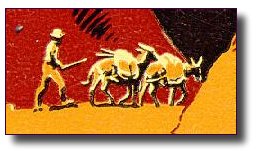




| |

| |
| Back to Core Works. |
|
Charles H. Huckaby. The legend of the Lost Dutchman's gold mine... 2003. The following text is from the 1stBook website. About the Book: In the vast Sonoran wastland, about twenty miles east of Phoenix, mighty granite mountains rise some four thousand feet above the desert floor. The Superstitions are the center of mystery and legend, tales that date from the Conquestidor to the lone miner and his burro. Today, it is said that these legends, old maps, and stone tablets hold the key to hidden treasures. Many have tried, and more than a few have lost their lives, in their search for the secrets of these forboding mountains. Still others have adapted and distorted history in their attempts to tell the stories of the Spanish mines and the Dutchman's lost gold. Here, in these pages, I will guide you through the path of history and present to you, now, the lost mines of the past . . . uncovered! Charles H. Huckabay: The author Charles Hoyt Huckabay, grew up around the superstition mountains and found many of the unknown areas that are there. Has a great knowledge of the history of Arizona and surrounding areas. Has been involved in training horses, rodeo, team roping and riding horse back into the wilderness all his life. Free Preview: A quiet fascination has troubled me for the past thirty-five years. As a boy, I lived in Chandler, Arizona. In the early 50's all the mountains in Arizona seemed remarkably close, as there was no air pollution. I was always able to look at the Superstition Mountains and make mental notes of obvious landmarks. By 1955, my father bought a new home in Apache Junction. It was at this time I met Barney Bernard, the author of a book about the Superstition Mountains and the Lost Dutchman Mine. My father was doing some construction work on Barney's home and I was helping him. This gave me the opportunity to enjoy several long talks with Barney. He first introduced me to the legend of the Lost Dutchman Mines. By 1957, I was making many trips into the Superstitions which lasted several days. I learned the different canyons and their names: First Water, Wiskey Springs, etc. I also learned the many trails with their Spanish names. I have spent many years learning about and finding different places in the Superstitions and have developed a great love for the mountains that has lasted until this day. In this book I will share with you many of the mysteries which I have uncovered, from the early Spanish conquest to the Dutchman and beyond. Because Barney Bernard shared his secrets with me, I also will share mine with you in hopes you may come to appreciate the rich history and beauty of the Superstition Mountains. >From between the twin peaks of Popocateptl and Ixtaclhuatl, the Spaniard gazed down upon the valley below. The year was 1519 and the moment marked the first time Spanish eyes had ever beheld the city of Tenochtitan, the site of the mighty Aztec nation. Within the massive stone walls, the ancient Indian civilization flourished. In the fields below, corn, beans, tomatoes, and squash grew abundantly. Tanned leather and beautiful cotton textiles were being traded in the marketplace. The buildings exhibited a mastery of the arts of carpentry and masonry. But, amidst all the majestic splendor, the vision that embedded itself into the mind of Hernando Cortez was that of the exquisitly crafted models of birds and fish--for they were solid gold! Riches, all to be claimed for his motherland. The fact that the Aztecs, under the rule of Montezuma II, forced tribute, as well as occasional human sacrifices, from the neighboring tribes was, undoubtably, reason enough for Cortez to find them easy allies. In 1521, Cortez led his Spanish troops, aided by these vengeful, rival tribes, to topple the Aztec empire. Montezuma II was killed, the great city destroyed, and the survivors made subject to Spanish rule. By 1522, a new city stood upon the once sacred ground of Tenochtitan. Under the guidance of Cortez, now governor, it would grow into what is now known as Mexico City. In 1535, Spain declared Mexico a viceroyalty, and to encourage settlement and Christianization, began the practice of bestowing land grants. Noblemen, military men, and the church landowners were entrusted with these responsibilities. At the same time and with great zeal, they began to ravage the land of its mineral wealth, sending the spoils back to Spain. In 1536, another explorer, Cabeza de Vaca, was sailing home after traveling with Panfilo de Narvaez to Florida. Tragedy struck and Vaca found himself, along with three other shipmates, the only surviviors as their vessel wrecked onto the coast of present day Texas. The small band trekked through what is now New Mexico to finally reach the Spanish frontier of Mexico. With them they brought stories of great cities of gold lying in the land to the north. The people began to wonder if the old Spanish legend of the seven cities of gold, in the lost region of Cibola, were really true. |
| Doug Stewart. © 1994-2012. |